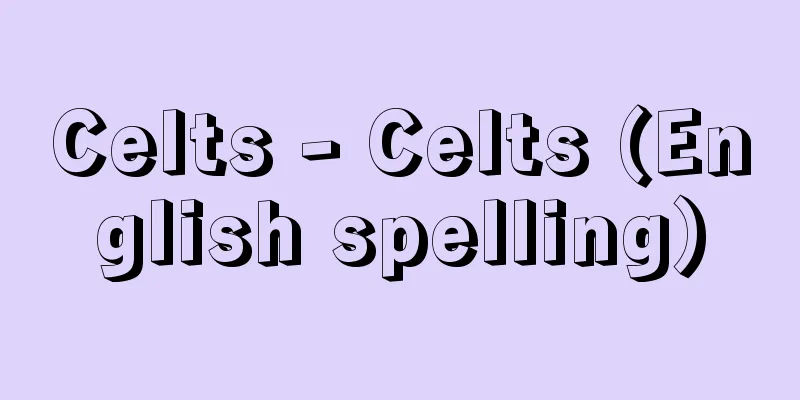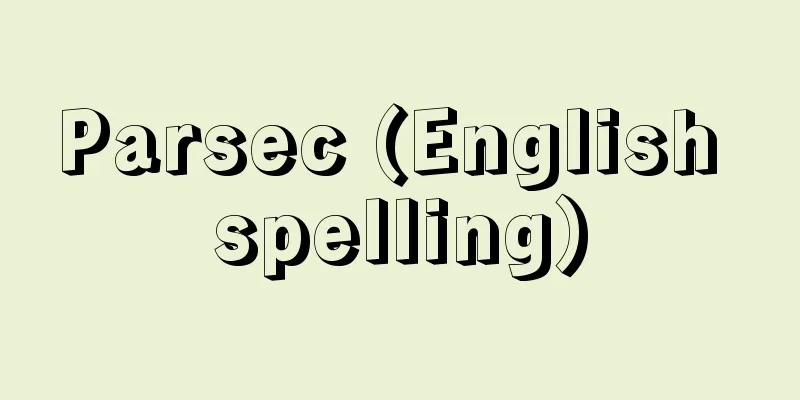Celts - Celts (English spelling)

|
A branch of the Indo-European peoples. They were active in central and western Europe from the 5th century BC to the 1st century BC. They were called the Celtoi or Galatoi in Greek, and the Celtae or Gallii (Gauls) in Latin. [Hasegawa Hirotaka] initialThere is some debate about their original habitat and origin, but they are believed to have been the bearers of the Bronze Age culture in southwestern Germany, Switzerland, and eastern France, and the Celts are thought to have formed as an ethnic group in Champagne, the Saar, the Moselle, and the Middle Rhine region during the Late Early Iron Age at Hallstatt and the earliest period of the Late Iron Age at La Tène. It is also believed that they were the bearers of the Hallstatt culture in the northwestern Alps, which clearly had exchanges with Greek and Etruscan culture. The tombs and artifacts excavated from the tombs of nobles in Champagne and the Middle Rhine region during the Early La Tène period in the 5th century BC show the essence of early Celtic art. [Hasegawa Hirotaka] Migration phase(1) "The Celts of the West" The Celts who invaded Italy ravaged Rome (Celtic Invasion) after the victory of Arria in 387 BC (or 390), and then settled on the Adriatic coast of northern Italy. One group, the Insubres, made Mediolanum (Milan) their capital, and the Boians made the Etruscan town of Felsina their town of Bononia. The Senones also settled on the Adriatic coast. After their defeat by the Roman army in 293 BC, the Celtic power in northern Italy also declined, but Rome responded by establishing colonies in various places. There are various theories about the time of the Celts' invasion of Spain and Britain, but it is believed to date back to the La Tène period. The Celtification of most of Gaul progressed, and in the Iberian Peninsula, the indigenous Iberians intermarried to form the Celt-Iberians. Meanwhile, the repeated influx of Celts from the continent led to the Celtification of Britain, and the Celtic language still survives today as Irish, Scottish Gaelic, and Welsh. (2) "Eastern Celts" Around the 4th century BC, one group traveled through Bohemia (a name derived from the Voi people), Moravia, and Hungary to enter northern Romania, while another group traveled through Noricum to Dalmatia. Around 279 BC, they invaded Delphi. One group moved north and established Singidunum (Belgrade), and another group entered Thrace and established a kingdom, and their influence extended to the southern Russian plain, where a Celtic-Scythian mixed culture was born. Furthermore, a group that had interfered in the succession to the throne of Bithynia in Asia Minor later settled in the Phrygian Plateau in the early 3rd century BC, and was given a region called Galatia by the King of Pergamum, and continued to preserve the traditions of Celtic society in Asia Minor. [Hasegawa Hirotaka] Late PeriodIn the 1st century BCE, the so-called oppidum (city) culture was established in the world of the warrior and agricultural Celts of Central Europe. However, the struggle for freedom that continued against Caesar's Gallic Wars came to an end in 52 BCE (the great uprising led by Vercingetorix), and between 16 and 10 BCE, the last Celtic strongholds on the continent came under Roman control, and Gaul, the land of the Celts, was completely Romanized. [Hasegawa Hirotaka] Politics, Society, and CultureIn Gaul and Britain, a kind of aristocratic system based on a hierarchical cliente system (a relationship of protection and servitude between superiors and subordinates) was maintained politically, but they never formed a unified nation. In ancient times, the economic base was on land belonging to a blood-related community, and coinage was also carried out. In general, the Celts' world consisted of kings, priests, warrior nobles, and free peasants, but the social structure is being clarified by excavations of cities and noble tombs. The power of the nobles was established and expanded through the construction of cities and the development of commerce and industry, but at the same time, the power of the priestly (Druid) class also extended to religion, culture, and politics. The doctrines and rituals of Druidism were not written down but were passed down orally, so they must be reconstructed from the descriptions, relics, and traditions of the Greeks and Romans. They are presumed to have had a unique system of gods centered on an Indo-Germanic cosmic god, but they believed in the immortality of the soul and were active in nature worship, and they also had faith in sacred trees, sacred beasts, sacred springs, and sacred mountains. He had an abstract, symbolic sense of form, and his art was characterized by abstract patterns and rhythmic forms. He showed outstanding talent in wood carvings such as wooden puppets, and metalwork for ornaments and weapons. [Hasegawa Hirotaka] "The Celts" by Gerhard Helm, translated by Seki Kusuo (1979, Kawade Shobo Shinsha) Source: Shogakukan Encyclopedia Nipponica About Encyclopedia Nipponica Information | Legend |
|
インド・ヨーロッパ諸族の一派。紀元前5世紀から前1世紀にヨーロッパ中部および西部で活躍した民族。ギリシア語でケルトイ、ガラトイ、ラテン語でケルタエ、ガリイ(ガリア人)とよばれた。 [長谷川博隆] 初期原住地、起源については議論があるが、南西ドイツ、スイス、東フランスの青銅器文化の担い手であり、初期鉄器時代のハルシュタット後期、後期鉄器時代のラ・テーヌ最初期に、シャンパーニュ、ザール、モーゼル、中部ライン地方において、民族としてのケルト人が形成されたと思われる。なお、ギリシア、エトルリア文化との交流も明らかな北西アルプス地方のハルシュタット文化は、彼らが担ったと推定される。ついで、前5世紀の、初期ラ・テーヌ時代のシャンパーニュ、中部ライン地方の貴族の墳墓および出土品は、初期ケルト美術の精華を示してくれる。 [長谷川博隆] 移動期(1)「西方のケルト人」 イタリアに侵入したケルト人は、前387年(または390年)のアッリアの勝利後、ローマを荒らし(ケルト人の侵寇(しんこう))、その後、北イタリアのアドリア海岸に定着した。一派のインスブレス人はメディオラヌム(ミラノ)を首邑(しゅゆう)とし、ボイ人はエトルスキの町フェルシナをボノニアとした。またアドリア海岸にはセノネス人が定住する。前293年にローマ軍に敗れたのちは、北イタリアのケルト勢力も衰えたが、ローマも各地に植民市を設けてこれに相対した。ケルト人のスペインおよびブリテン島侵入の時期については諸説あるが、ラ・テーヌ期にさかのぼると推定される。ガリアの地の大部分のケルト化も進み、イベリア半島では、先住のイベロ人と混血してケルト・イベロ人が形成され、一方、大陸からのたび重なるケルト人の渡来によりブリテン島のケルト化も進み、現在でも、アイルランド語、スコットランド・ゲール語、ウェールズ語として、ケルト語は生き続ける。(2)「東方のケルト人」 前4世紀ごろ、一派はボヘミア(ボイ人からきた名称)、モラビア、ハンガリーを経てルーマニア北部に入り、他の一派はノリクムを経てダルマチアに移動した。前279年ごろにはデルフォイを侵寇している。北に転じた一派はシンギドゥヌム(ベルグラード)を建て、別の一派はトラキアに入って王国を建設し、その影響力は南ロシア平原まで及び、ケルト、スキタイ混交文化も生まれた。さらに、小アジアのビテュニアの王位継承に干渉した一派は、その後、前3世紀初めフリギア高原に定着し、ガラティアとよばれる地域をペルガモン王から与えられ、小アジアの地にケルト人社会の伝統を保持し続けた。 [長谷川博隆] 後期前1世紀には、いわゆるオッピドゥム(城市)文化が中部ヨーロッパの戦士、農耕民のケルト人の世界に確立した。しかし、カエサルのガリア戦争に対して続けられた自由を求める闘争も、前52年に終止符を打ち(ウェルキンゲトリクスの率いる大蜂起(ほうき))、前16~前10年には、大陸の最後のケルト人の拠点もローマの支配下に入り、ケルト人の地、ガリアは完全にローマ化する。 [長谷川博隆] 政治・社会・文化ガリアやブリテン島では、政治的には、段階的なクリエンテス制(上下の保護隷属関係)に基づく一種の貴族制的体制が保たれたが、ついに統一国家を形成することはなかった。経済的基盤は、古くは血縁的な共同体に属する土地にあり、貨幣の鋳造も行われた。一般に、ケルト人の世界は、王、神官、戦士貴族および自由農民からなったが、城市や貴族の墳墓の発掘によって、その社会構成も明らかにされつつある。城市の建設、商・工業の発展によって貴族の権力が確立、伸長してゆくが、それとともに神官(ドルイド僧)層の力も、宗教、文化、政治に及んでゆく。ドルイド教の教義、儀式は、文字化されず口伝によるため、ギリシア・ローマ人の叙述、遺物、伝承によって再構成せざるをえない。彼らは、インド・ゲルマン人的な宇宙神を中心とする独特の神の体系をもっていたと推定されるが、霊魂不滅を信じ、自然崇拝が盛んで、聖樹、聖獣、聖泉、聖山信仰などもみられた。抽象的、記号的性格の造形感覚をもち、その美術は、抽象文様、形態のリズム化を特徴とし、木偶(もくぐう)などの木彫、装身具・武具としての金工細工などに卓越した才幹を示した。 [長谷川博隆] 『ゲルハルト・ヘルム著、関楠生訳『ケルト人』(1979・河出書房新社)』 出典 小学館 日本大百科全書(ニッポニカ)日本大百科全書(ニッポニカ)について 情報 | 凡例 |
Recommend
Indirect Sulfonation - A Book to Explain
… Aliphatic aldehydes, ketones, carboxylic acids,...
images d'Epinal (English) images dEpinal
…Inheriting the crudeness and low price of 15th-c...
Mount Otakine
This mountain is located in the eastern part of F...
Utagawa Toyokuni (III)
...The play premiered in March 1862 (Bunkyu 2) at...
pantokratōr (English spelling) pantokrator
…However, in the West, the former type can be fou...
Kiranin, MM - Kiranin
…Following this, all major international tennis t...
Soan Culture
A Paleolithic culture distributed in the northwes...
Ishihara Sangyo Incident
…Capital: 37 billion yen (May 1998), sales: 83.6 ...
cutch tree
...In Malaysia, the leaves are chewed with betel ...
Toraj - Toraj
This is the title of a Korean folk song. It is mo...
Marino Moretti
Italian poet and novelist. Born in Romagna. At a ...
Ichiigashi - Ichiigashi
It is a large evergreen tree of the Fagaceae fami...
Antiferromagnetism
...When the temperature rises and the thermal ene...
obsessional idea
… Disorders of thought content include dominant i...
Motion pictures
An old name for movies. A translation of the word ...

![Arkansas [River] - Arkansas](/upload/images/67cf20df45523.webp)







